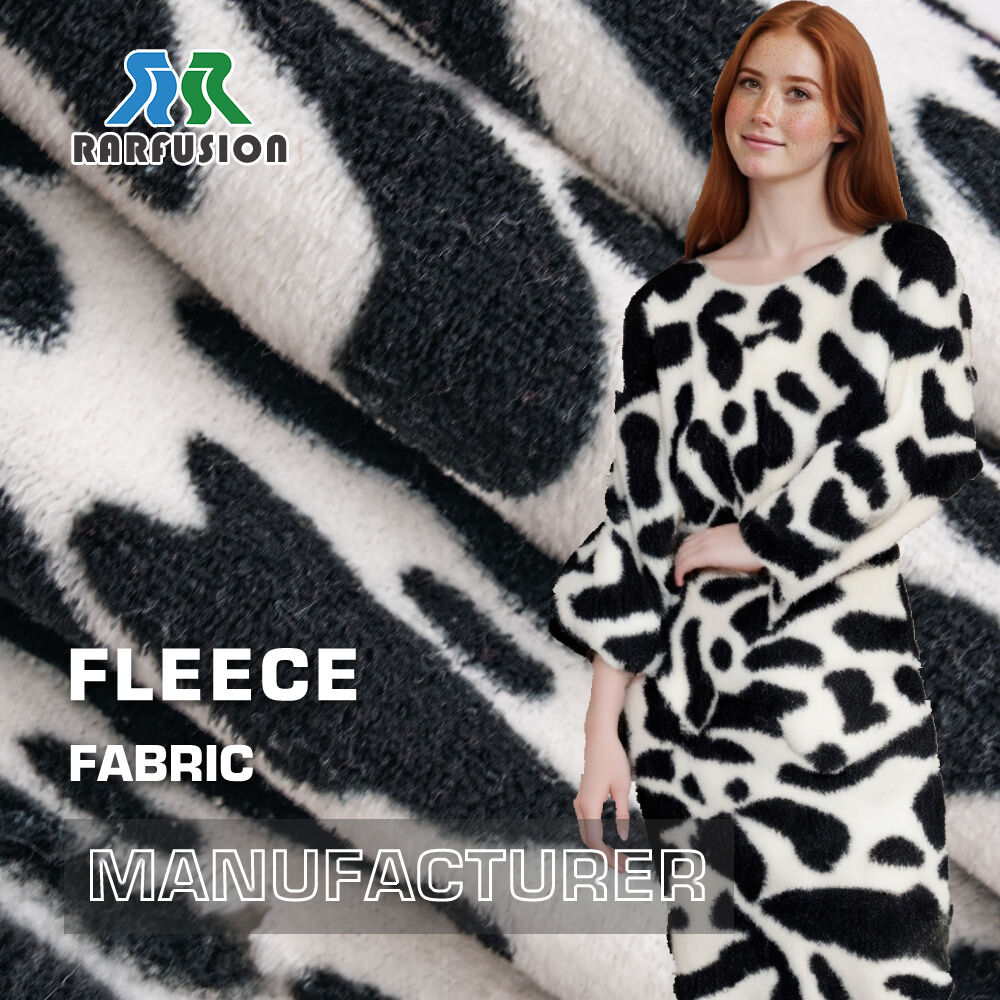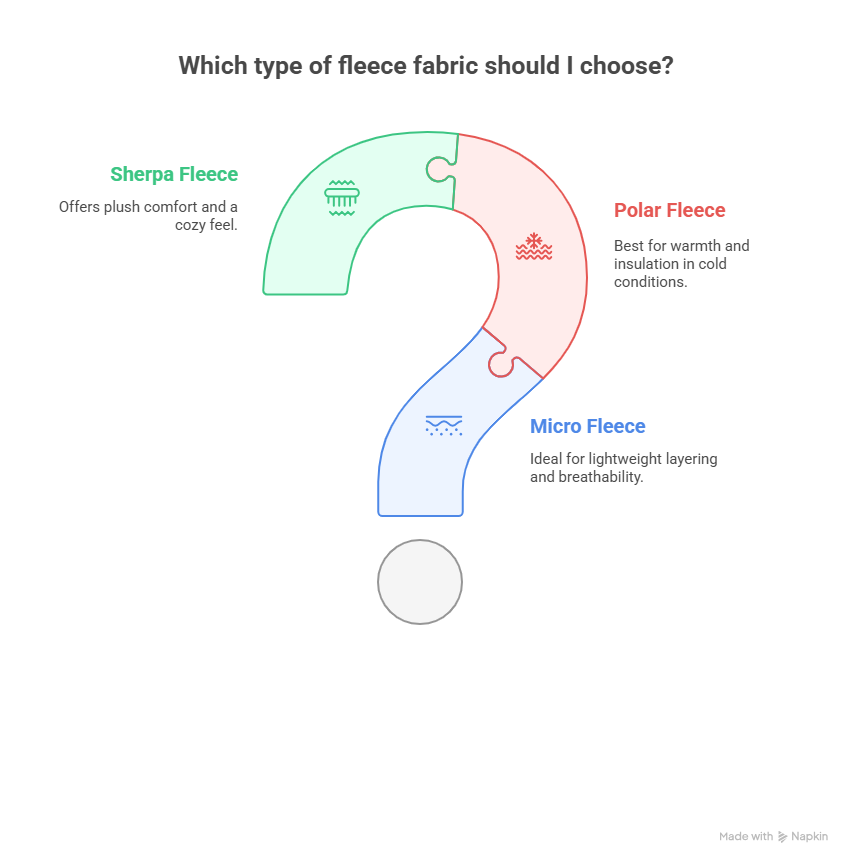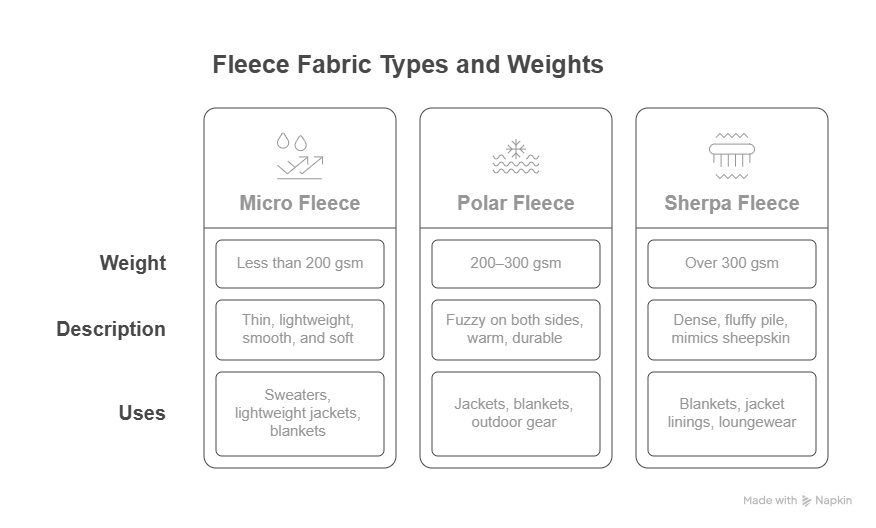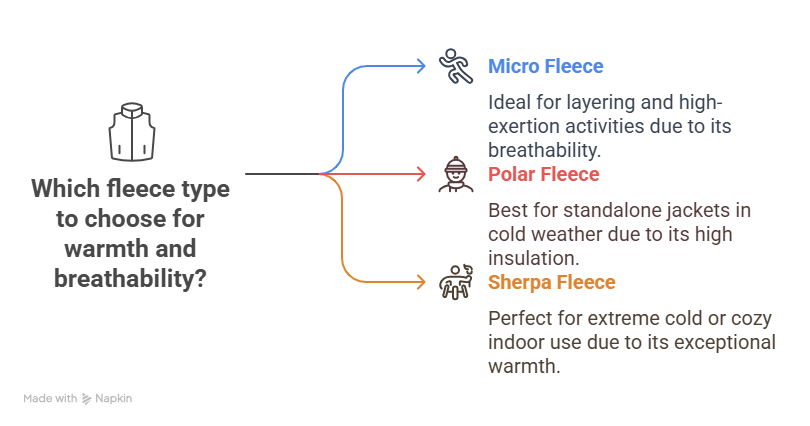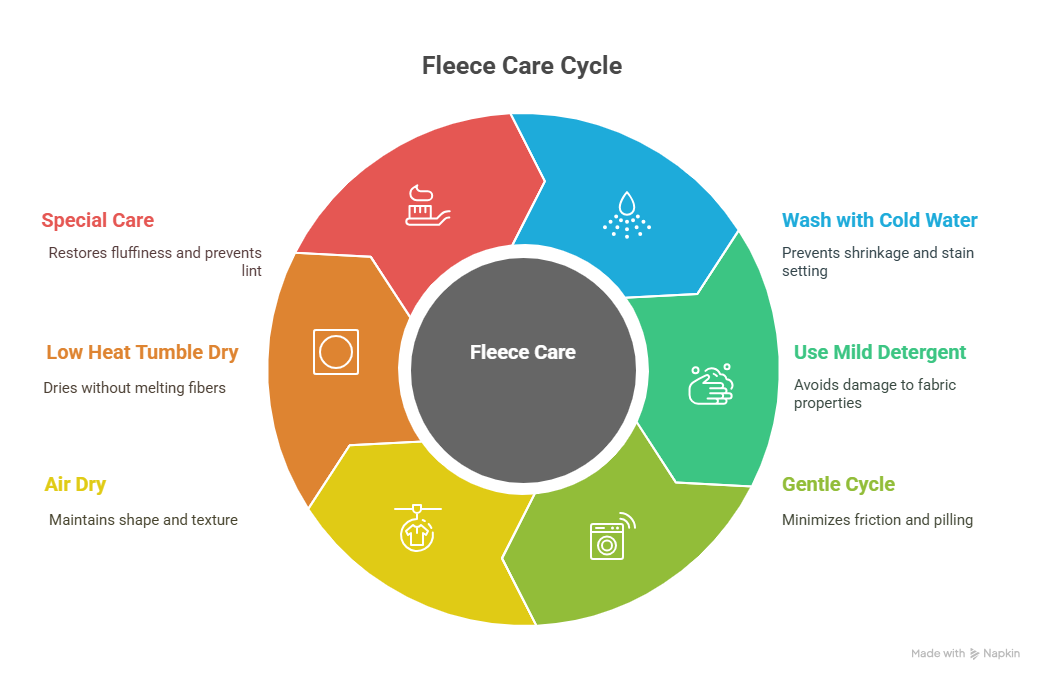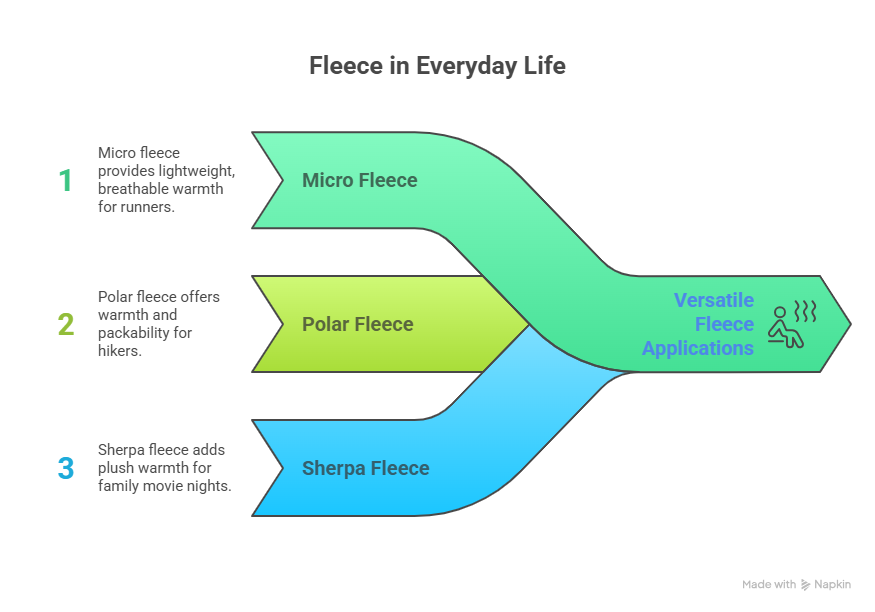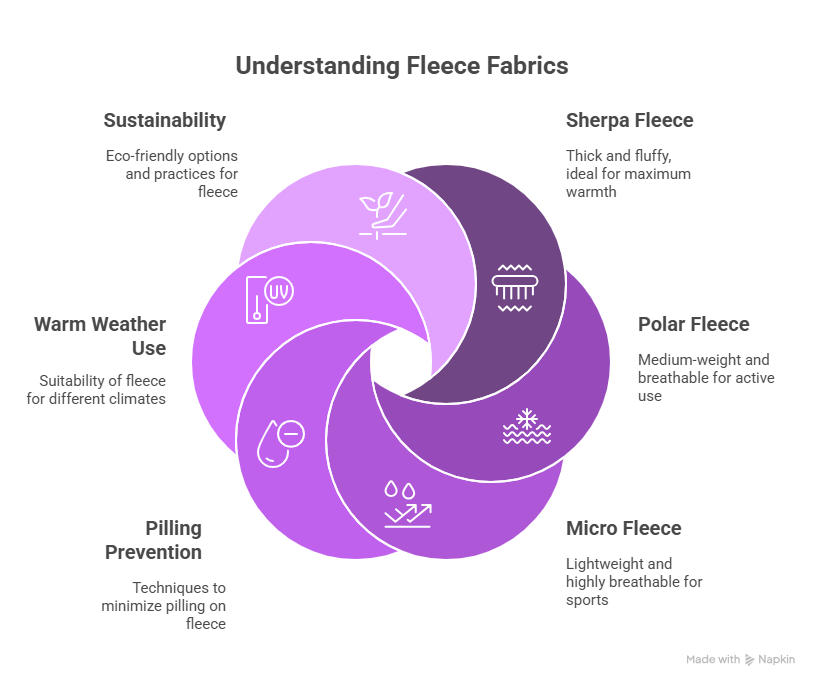Understanding Fleece Fabrics: The Composition of Micro, Polar, and Sherpa Fleece
Table of Contents
-
What Are Micro, Polar, and Sherpa Fleece Fabrics?
-
Types and Weights of Fleece Fabrics
-
Key Features: Warmth and Breathability
-
How to Wash and Care for Fleece Fabrics
-
Real-World Uses for Fleece Fabrics
-
Sustainability and Ethical Considerations
-
FAQs About Fleece Fabrics
What Are Micro, Polar, and Sherpa Fleece Fabrics?
Struggling to choose the right fleece for your outdoor adventures or cozy home essentials? Fleece fabrics like micro, polar, and sherpa offer unique benefits, but their differences can feel overwhelming. Let’s break it down clearly.
Fleece is a synthetic fabric, typically made from polyester, designed to mimic wool’s warmth while being lighter and easier to care for. Invented in 1979 by Malden Mills (now Polartec), fleece revolutionized outdoor gear with its insulating properties and versatility. Micro, polar, and sherpa are distinct types, each tailored to specific needs, from lightweight layering to plush comfort.
Why It Matters: Understanding these fleece types helps you pick the right one for your jacket, blanket, or activewear, ensuring comfort and performance.
Types and Weights of Fleece Fabrics
Not all fleece is created equal. Here’s a detailed look at micro, polar, and sherpa fleece, including their weights and common uses.
Micro Fleece
- Weight: Less than 200 grams per square meter (gsm).
- Description: Thin and lightweight, micro fleece is smooth and soft, often used as a base layer or in baby clothing due to its gentle texture.
- Uses: Sweaters, lightweight jackets, blankets, and sportswear.
- Example: A micro fleece pullover for a chilly morning run.
Polar Fleece
-
Weight: Medium-weight, typically 200–300 gsm.
-
Description: Thicker than micro fleece, polar fleece has a fuzzy texture on both sides, offering excellent warmth without bulk. It’s durable and affordable.
-
Uses: Jackets, blankets, and outdoor gear like hoodies.
-
Example: A polar fleece jacket for hiking in cool weather.
Sherpa Fleece
-
Weight: Heavy, often over 300 gsm.
-
Description: Mimics sheepskin with a dense, fluffy pile on one side and a smooth surface on the other. Sherpa is the warmest and plushest fleece type.
-
Uses: Blankets, jacket linings, and loungewear.
-
Example: A sherpa-lined throw for cozy movie nights.
Pro Tip: Check the gsm on product labels to gauge warmth and thickness. Lighter weights suit active use, while heavier ones are ideal for stationary warmth.
Key Features: Warmth and Breathability
Fleece fabrics excel at keeping you warm, but their breathability varies. Here’s how micro, polar, and sherpa stack up.
Warmth
- Micro Fleece: Moderately warm, perfect for layering under a shell jacket during mild winters. Less insulating than heavier fleeces.
- Polar Fleece: Highly insulating, trapping heat close to the body. Ideal for standalone jackets in cold weather.
- Sherpa Fleece: Exceptionally warm due to its thick pile, best for extreme cold or cozy indoor use.
Breathability
- Micro Fleece: Highly breathable, making it ideal for high-exertion activities like running or skiing. It wicks moisture effectively.
- Polar Fleece: Moderately breathable, suitable for outdoor activities but may feel warm during intense exercise.
- Sherpa Fleece: Less breathable due to its dense structure, better for low-activity settings like camping or lounging.
Real-World Scenario: Imagine hiking in 40°F weather. A micro fleece base layer keeps you warm without overheating, while a polar fleece jacket adds insulation. For a chilly evening campfire, swap to a sherpa-lined blanket for maximum coziness.
Expert Insight: “Micro fleece is my go-to for active adventures because it breathes so well, while sherpa is unbeatable for warmth when I’m stationary,” says outdoor gear tester Sarah Johnson.
How to Wash and Care for Fleece Fabrics
Worried about pilling or microplastic shedding? Proper care keeps your fleece soft, durable, and eco-friendly. Follow these steps.
Washing Instructions
-
Use Cold Water: Hot water can shrink fleece or set stains.
-
Mild Detergent: Avoid bleach or fabric softeners, which reduce breathability and moisture-wicking properties.
-
Gentle Cycle: Minimizes friction to prevent pilling.
-
Microplastic Tip: Use a Guppy Friend wash bag to catch microfibers and reduce environmental impact.
Drying Instructions
-
Air Dry: Hang fleece to maintain shape and texture. It dries quickly.
-
Low Heat Tumble Dry: If needed, use a low heat setting to avoid melting synthetic fibers.
-
Avoid High Heat: High temperatures can damage fleece and cause pilling.
Special Care Tips
-
Sherpa Fleece: Brush gently with a soft brush to restore fluffiness after washing.
-
Polar Fleece: Wash with similar colors to prevent lint attraction.
-
Micro Fleece: Check for pilling and use a fabric shaver if needed.
Warning: Keep fleece away from open flames, as it can melt quickly.
Real-World Uses for Fleece Fabrics
Fleece’s versatility shines in various scenarios. Here are practical examples of how each type fits into daily life.
-
Micro Fleece: A runner layers a micro fleece shirt under a windbreaker for a winter trail run. Its breathability prevents overheating, and its lightweight design doesn’t weigh them down.
-
Polar Fleece: A camper wears a polar fleece jacket during a fall hike. It keeps them warm during breaks and packs easily into a backpack.
-
Sherpa Fleece: A family snuggles under a sherpa fleece blanket during a winter movie marathon. Its plush texture adds instant warmth.
Customer Review: “I bought a sherpa fleece throw for my couch, and it’s the coziest thing ever. It washes well, but I use a gentle cycle to keep it fluffy,” says Amazon reviewer Jane D.
FAQs About Fleece Fabrics
What’s the difference between sherpa and polar fleece?
Sherpa fleece is thicker with a fluffy, sheepskin-like texture, ideal for maximum warmth. Polar fleece is medium-weight, fuzzy on both sides, and more breathable for active use.
Is micro fleece good for outdoor sports?
Yes, micro fleece is lightweight and highly breathable, making it perfect for activities like running or skiing.
How do I prevent pilling on my fleece jacket?
Wash on a gentle cycle with cold water, avoid fabric softeners, and air dry to minimize pilling. Use a fabric shaver for existing pills.
Can sherpa fleece be used in warm weather?
Sherpa fleece is too warm for hot climates due to its dense pile. Opt for micro fleece for better breathability in milder weather.
Are fleece fabrics sustainable?
Fleece can be eco-friendly if made from recycled polyester or natural fiber blends. Use a microplastic-catching wash bag to reduce environmental impact.

